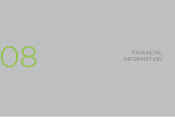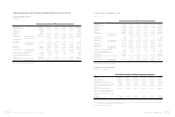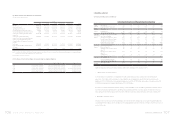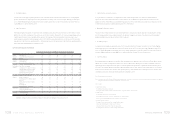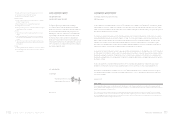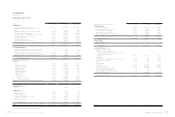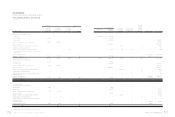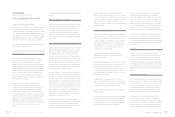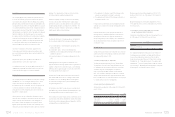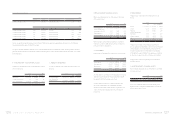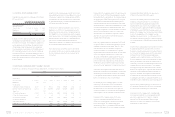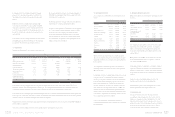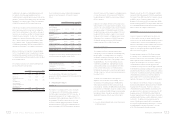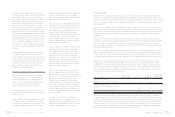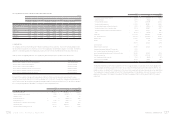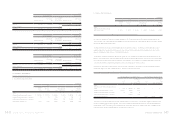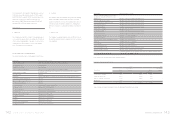HTC 2010 Annual Report Download - page 62
Download and view the complete annual report
Please find page 62 of the 2010 HTC annual report below. You can navigate through the pages in the report by either clicking on the pages listed below, or by using the keyword search tool below to find specific information within the annual report.
122 2 0 1 0 H T C A N N U A L R E P O R T 123
FINANCIAL INFORMATION
would have been determined had no impairment loss been
recognized for the investment in prior years.
Financial Assets Carried at Cost
Investments in equity instruments with no quoted prices in
an active market and with fair values that cannot be reliably
measured, such as non-publicly traded stocks and stocks
traded in the emerging stock market, are measured at their
original cost. The accounting treatment for dividends on
financial assets carried at cost is similar to that for dividends
on available-for-sale financial assets. An impairment loss is
recognized when there is objective evidence that the asset is
impaired. A reversal of this impairment loss is disallowed.
Investments Accounted for by the Equity Method
Investments in which the Company holds 20 percent or more
of the investees’ voting shares or exercises significant influence
over the investees’ operating and financial policy decisions are
accounted for by the equity method.
Prior to January 1, 2006, the dierence between the acquisition
cost and the Company’s proportionate share in the investee’s
equity was amortized by the straight-line method over five
years. Eective January 1, 2006, pursuant to the revised
Statement of Financial Accounting Standard (SFAS) No. 5,
“Long-term Investments Accounted for by Equity Method”, the
acquisition cost is allocated to the assets acquired and liabilities
assumed based on their fair values at the date of acquisition,
and the excess of the acquisition cost over the fair value of
the identifiable net assets acquired is recognized as goodwill.
Goodwill is not being amortized. The excess of the fair value of
the net identifiable assets acquired over the acquisition cost is
used to reduce the fair value of each of the noncurrent assets
acquired (except for financial assets other than investments
accounted for by the equity method, noncurrent assets held
for sale, deferred income tax assets, prepaid pension or other
postretirement benefit) in proportion to the respective fair
values of the noncurrent assets, with any excess recognized
as an extraordinary gain. Eective January 1, 2006, the
accounting treatment for the unamortized investment
premium arising on acquisitions before January 1, 2006 is the
same as that for goodwill and the premium is no longer being
amortized. For any investment discount arising on acquisitions
before January 1, 2006, the unamortized amount continues to
be amortized over the remaining year.
Profits from downstream transactions with an equity-method
investee are eliminated in proportion to the Company’s
percentage of ownership in the investee; however, if the
Company has control over the investee, all the profits are
eliminated. Profits from upstream transactions with an equity-
method investee are eliminated in proportion to the Company’s
percentage of ownership in the investee.
When the Company subscribes for its investee’s newly issued
shares at a percentage dierent from its percentage of
ownership in the investee, the Company records the change
in its equity in the investee’s net assets as an adjustment to
investments, with a corresponding amount credited or charged
to capital surplus. When the adjustment should be debited to
capital surplus, but the capital surplus arising from long-term
investments is insucient, the shortage is debited to retained
earnings.
Properties
Properties are stated at cost less accumulated depreciation.
Borrowing costs directly attributable to the acquisition or
construction of properties are capitalized as part of the cost of
those assets. Major additions and improvements to properties
are capitalized, while costs of repairs and maintenance are
expensed currently.
Assets held under capital leases are initially recognized as
assets of the Company at the lower of their fair value at the
inception of the lease or the present value of the minimum
lease payments; the corresponding liability is included in the
balance sheet as obligations under capital leases. The interest
included in lease payments is expensed when paid.
Depreciation is calculated on a straight-line basis over the
estimated service lives of the assets plus one additional year
for salvage value: buildings (including auxiliary equipment) -
3 to 50 years; machinery and equipment - 3 to 5 years; oce
equipment - 3 to 5 years; transportation equipment - 5 years;
and leasehold improvements - 3 years.
Properties still in use beyond their original estimated useful
lives are further depreciated over their newly estimated useful
lives.
The related cost (including revaluation increment) and
accumulated depreciation are derecognized from the balance
sheet upon its disposal. Any gain or loss on disposal of the
asset is included in nonoperating gains or losses in the year of
disposal.
If the properties are leased to others, the related costs and
accumulated depreciation would be transferred from properties
to other assets - assets leased to others.
Intangible Assets
Intangible assets acquired are initially recorded at cost and are
amortized on a straight-line basis over their estimated useful
lives. Patents are amortized on a straight-line basis over 5 to 10
years.
Deferred Charges
Deferred charges are telephone installation charges, computer
software costs and deferred license fees. Installation charges
and computer software are amortized on a straight-line basis
over 3 years, and deferred license fees, over 10 years.
Asset Impairment
If the recoverable amount of an asset is estimated to be less
than its carrying amount, the carrying amount of the asset
is reduced to its recoverable amount. An impairment loss is
charged to earnings unless the asset is carried at a revalued
amount, in which case the impairment loss is treated as a
deduction to the unrealized revaluation increment.
If an impairment loss subsequently reverses, the carrying
amount of the asset is increased accordingly, but the increased
carrying amount may not exceed the carrying amount that
would have been determined had no impairment loss been
recognized for the asset in prior years. A reversal of an
impairment loss is recognized in earnings, unless the asset
is carried at a revalued amount, in which case the reversal of
the impairment loss is treated as an increase in the unrealized
revaluation increment. A reversal of an impairment loss on
goodwill is disallowed.
For long term equity investments for which the Company has
significant influence but with no control, the carrying amount
(including goodwill) of each investment is compared with its
own recoverable amount for the purpose of impairment testing.
Accrued Marketing Expenses
The Company accrues marketing expenses on the basis of
agreements, management’s judgment, and any known factors
that would significantly aect the accruals. In addition,
depending on the nature of relevant events, the accrued
marketing expenses are accounted for as an increase in
marketing expenses or as a decrease in revenues.
Reserve for Warranty Expenses
The Company provides warranty service for one to two years
depending on the contract with customers. The warranty
liability is estimated on the basis of management’s evaluation
of the products under warranty, past warranty experience, and
pertinent factors.
Product-related Costs
The cost of revenues consists of costs of goods sold, write-
downs of inventories and the reversal of write-downs. The
provisions for product warranty are estimated and recorded
under cost of revenues when sales are recognized.
Pension Plan
Pension cost under a defined benefit plan is determined by
actuarial valuations. Contributions made under a defined
contribution plan are recognized as pension cost during the
year in which employees render services.
Curtailment or settlement gains or losses on the defined
benefit plan are recognized as part of the net pension cost for
the year.


